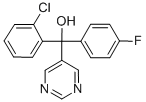Uses
Nuarimol is used in the preparation of difluoroethyl-containing heterocyclic compounds useful as antiviral agents and fungicides. Also used as a substance in the modelling inhibition of avian aromatase by azole pesticides.
Uses
Nuarimol is a systemic fungicide with both curative and protective
activity. It controls a wide range of pathogenic fungi, e.g. Cercosporella
spp., Septoria spp., Ustilago spp., powdery mildews, leaf spot, etc. in cereals
(as a foliar spray and as a seed treatment), powdery mildews on
pome fruits, stone fruits, vines, cucurbits and other crops and scab on
apples.
Metabolic pathway
Photolytic degradation is the primary dissipation mechanism of nuarimol
in the environment. Major degradation reactions observed on plants/soil
surfaces and water include hydroxylation of the phenyl groups, oxidation
of the carbinol carbon atom, dehalogenation and carbinol dehydroxylation
(Scheme 1). The primary metabolic pathway of nuarimol in rats
involves mainly aryl hydroxylation (Scheme 2).
Degradation
Nuarimol is stable to hydrolytic degradation when maintained in sterile
buffered solutions (pH 3,6 and 9) in the dark at 52 °C (Saunders, 1977). It
was readily degraded in distilled water via photolysis. The photolytic
DT
50 of nuarimol was approximately 1 hour. Numerous photoproducts
were observed; however, no structural characterisation information was
reported (Zornes and Donoho, 1978).
Nuarimol was extensively photodegraded on solid surfaces. More than
80 photodegradation products were observed when nuarimol was
exposed to sunlight on a stainless steel surface for up to 150 hours (Althaus, 1980a). All photoproducts were formed at very low levels (less
than 3% each). The structures of 23 photoproducts were identified. An
abbreviated photodegradation pathway of nuarimol (based on products
accounting for 1% or greater) is presented in Scheme 1. These products
were generated from the following reactions: aryl hydroxylation of the
chlorophenyl and fluorophenyl moieties (to yield 2, 3), cleavage of the
pyrimidine ring and the oxidation of the carbinol carbon atom (4,5) and
dehydroxylation of the carbinol moiety (6). Carboxylic acid fragments
from the phenyl(7,8,9) and pyrimidine moieties (10), resulting from the
cleavage of the parent phenyl and pyrimidine linkages, were also
observed.


